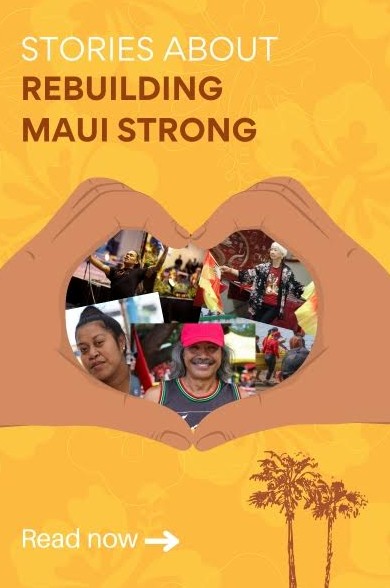By Yiming Fu, Report for America corps member
Maui County wants to drill another well to combat Lahaina’s water shortages.
But the real issue, locals say, is the unconstitutional water management system that direct 77% of Maui’s water to private developers and leave 23% for Maui’s people.
“We all say that water is life,” Lahainaluna High School junior Kuheleloa Kapu Kekona said. “So why do you keep letting it fall into the wrong hands?”
Hundreds of residents and dozens of local students packed Lahaina’s Civic Center this week to testify against the well and to return water to the people. They grieved their brown and drying homelands as hotels down the road flaunt green golf courses, pools and water fixtures.
The Commission of Water Resource Management hosted the meeting to rule on the new well. Two days before the meeting, Maui County pulled the well request. The committee, which doesn’t often visit Lahaina, still held the meeting to hear testimony. Residents testified until 6:00 p.m.
While residents were curious why the request was pulled and when it would come back, the commission was not able to answer on behalf of the county.
It’s time to return water back to the people, kumu Sesame Shim said, Maui’s people have compromised too much.
In the middle of her testimony, Shim pulled out a cream pie cut to symbolize 77% and 23%. She held up the smaller slice in front of the commission.
“If we can’t all share this 23%, we got to start eating the plate,” Shim said. “Appalling. Seventy-seven and twenty-three. That’s hewa.”

Far too dry
The Hawaii State Constitution says water is a public trust and prioritizes water for Native Hawaiian practices like kalo cultivation.
Next on the priority list are affordable housing, Hawaiian Homes, environmental needs and public use.
Resorts are the lowest priority.
But locals are not seeing that water. Formerly a lush wetland carefully tended by Native Hawaiians, the colonial plantation system diverted Maui’s water to private properties, leaving the rest of Lahaina a tinderbox of brown and drying grasses.
Lauren Palakiko is the wife of a kalo farmer. She said the kalo crops are rotting because they don’t get enough water. And O’opu, an important fish in Hawaiian culture are endangered and dying as streams dry up.
After the Lahaina fires, affordable housing developments that want to break ground cannot because they don’t have enough water.
Glenn Gazman said he’s frustrated that generational Lahaina residents have to follow water restrictions while the hotels and luxury homes do not.
He used to grow his own vegetables and make poi at home.
“Now if you come to my aina, it’s totally dry. My plants, my fruit trees, my kalo are struggling to survive,” Gazman said.
He wants stronger restrictions on private water owners who hoard the water.
“I feel that if the residents have to adhere to any restrictions, then those people there need to follow the same restrictions that we have.”
Chris Furumoto testified on behalf of Kapalua Golf, saying they have followed Hawaii Water Service restrictions since September 2024.
Furumoto wants to collaborate with the state on irrigation.
“We understand the irrigation of golf facilities is not a public trust use of water,” Furumoto said. “Our crop is grass. But our grass, it does one thing really well. It recharges out aquifers.”

Generational kuleana
Maui native environmental attorney Mahesh Cleveland said even with water shortages, another well is not the solution. Lahaina’s aquifers are already over-stressed and turning salty as a result.
Another well could have large consequences on the entire water system, Cleveland said.
The commission’s Deputy Director Ciara Kahahane proposed a tiered permitting system where all water uses have to apply to use water and cannot exceed a certain amount.
Others also advocated for standards to set a minimum amount of water that must stay in the streams.
Regardless, residents advocated for changes immediately so their kids don’t have to keep testifying at water meetings to access their basic rights.
Ku’ulei Palakiko said his late father stood before commissions testifying about water. Now he’s doing it. And his son is too.
“And now I introduce you to my grandson,” Palakiko said, patting his grandson on the back as he testifies. “Hewa if he’s going to be a 20-something-year old man having to sit in front of a commission and talk about the continuation of our fight for us to be pono with our wai.

Support our June Membership Drive and receive member-only benefits. We are 32% of our goal of $10,000 in new donations and monthly and annual donation pledges and 25% of our goal of gaining 25 new monthly donors by the end of the Month.
We are published by the non-profit Asian American Media Inc and supported by our readers along with the Robert Wood Johnson Foundation, AARP, Report for America/GroundTruth Project & Koo and Patricia Yuen of the Yuen Foundation.
You can make your tax-deductible donations here via credit card, debit card, Apple Pay, Google Pay, PayPal and Venmo. Stock donations and donations via DAFs are also welcomed. Contact us at info @ asamnews dot com for more info.




